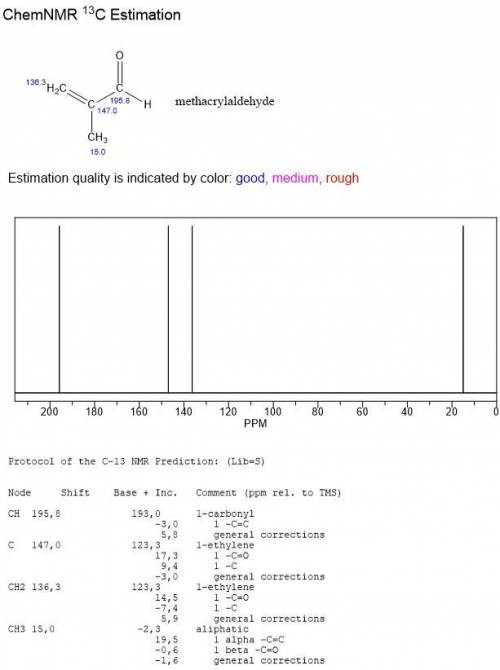
Chemistry, 26.11.2019 06:31 redraider4915
Acompound, c4h6o, exhibits ir absorption at 1705 cm-1. its carbon nmr shifts are given below. the number of hydrogens at each carbon, determined by dept, is given in parentheses after the chemical shift. 13c nmr: δ 14.0 (3), 134.4 (2), 146.0 (0), 194.7 (1) draw the structure of this compound

Answers: 2
Another question on Chemistry

Chemistry, 21.06.2019 18:30
In an oxidation-reduction reaction, oxidation is what happens when a reactant
Answers: 1

Chemistry, 22.06.2019 03:10
Between 2014 and 2016, more than 25,000 children in flint, michigan, drank water that was contaminated with lead from lead pipes. during this time, the city claimed the water was safe to drink. which of these actions could the city have taken to ensure that the drinking water was free from lead?
Answers: 3

Chemistry, 22.06.2019 09:00
Scientific evidence tells us that the cause of earths four season is the tilt of earth as it revolves around the sun. the student is instructed to illustrate this information in a science notebook. how will the student illiterate winter in the northern hemisphere?
Answers: 3

Chemistry, 22.06.2019 17:30
98 points you will be galileo perform the experiment to determine if objects with different mass fall at the same, or different, rates in the air and in a vacuum. before you conduct your experiment, you need to form a hypothesis. a hypothesis is a prediction of what you think will happen in the experiment. the hypothesis is a statement that describes “if” a certain set of circumstances are present “then” there will be a specific result that will occur. record your hypothesis here: record the results from step one of the experiment (dropping the objects in the air): first trial: second trial: third trial: record the results from step two of the experiment (dropping the objects in a vacuum): first trial: second trial: third trial: did the experiment support your hypothesis? using the data from your experiment, describe why you believe your hypothesis was either proven or disproven. what forces were acting on the objects dropped in the air? what force was acting on the objects dropped in the vacuum? part two: comparing forces choose two forces and compare and contrast these forces. you must provide two ways that they are alike and two ways that they are different. you may make a list, write in paragraph form, or make a chart. choose two forces and compare and contrast these forces. these must be different forces than used in the prior question. provide two ways that they are similar and two ways that they are different. you may make a list, write it out, or make a chart.
Answers: 3
You know the right answer?
Acompound, c4h6o, exhibits ir absorption at 1705 cm-1. its carbon nmr shifts are given below. the nu...
Questions

Chemistry, 12.08.2020 07:01

Mathematics, 12.08.2020 07:01



Mathematics, 12.08.2020 07:01









Mathematics, 12.08.2020 07:01

Mathematics, 12.08.2020 07:01



Engineering, 12.08.2020 07:01




 , for the signal at 134.2 we will have a
, for the signal at 134.2 we will have a  and for the signal at 146.0 we will have a quaternary carbon (no hydrogens present).
and for the signal at 146.0 we will have a quaternary carbon (no hydrogens present). 


